How to Find Flea Markets in France
Finding antique shops, brocantes & thrift stores in the French countryside
Every summer we go on a road trip of sorts, sometimes to visit and stay with friends, other times we stay in gites, which are rental houses or apartments* usually in rural locations, or chambres d’hôtes, bed-and-breakfasts where you get a room in a home. Breakfast is often in a common dining room, and you mingle with other guests. I’m not especially fond of socializing until well after I’ve had my morning coffee, but my partner makes up for it and is happy to carry on spirited conversations while I do my best to welcome the day at my own (sloooooow) pace.
But I will get up for a flea market, and one thing we do share in common is that Romain likes going to them too. His father had a stall at the Saint-Ouen flea market in Paris, so he knows a fair amount about French antiques. I wrote more about Paris flea markets and thrift stores here.
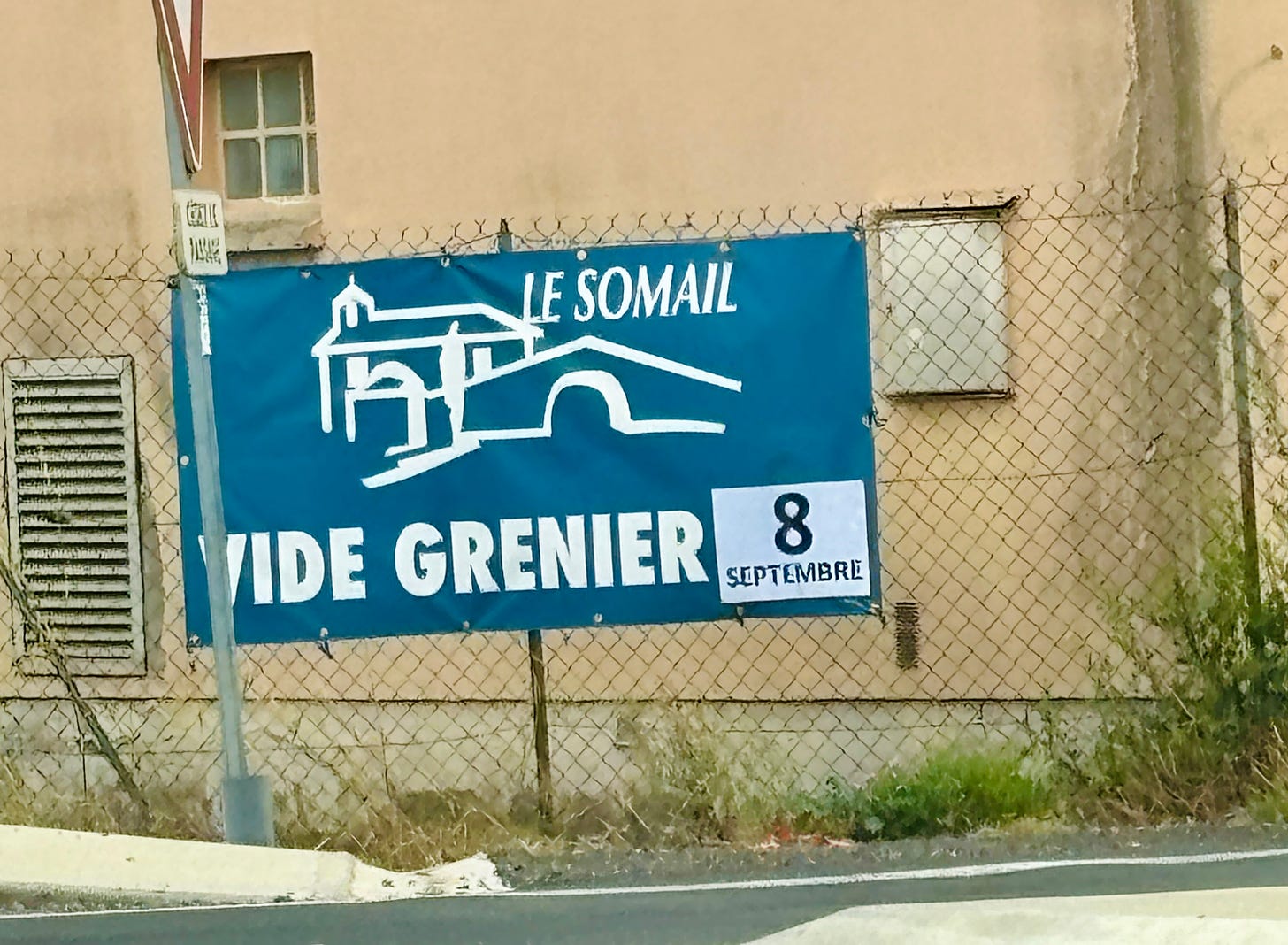
Scattered throughout France are antique stores, consignment shops, thrift stores, and flea markets, which usually take place in warmer months — especially the summer. They can be hit-or-miss, and it’s disappointing when it’s a miss…and great fun when it’s a hit. You never know. Same with thrift stores. Some are real duds with lots of plastic children’s toys, CDs, and cheap housewares, but I’ve scored some great things at others.
A FAQ I get is “Where do you keep everything?” which is curious because when I’m in the States and see people with overloaded shopping carts at Costco or Trader Joe’s, it doesn’t occur to me to ask someone with sixteen cartons of Top Ramen, two dozen boxes of Trojan’s, or ninety-six rolls of toilet paper where they store all that stuff or, in some cases, how fast they’re planning to go through it.
For the record, pretty much everything I get is used for cooking or serving, so everything either goes on my kitchen shelves or in a small storage shed I have to store bakeware and cooking supplies. A few things linger in my home office, which float between the kitchen and the storage shed. So there ya go.
Another question I get is how to find the flea markets in France. Most are found because we arrive somewhere and see signs for them while driving around. When I do, I snap a picture of the sign with my camera phone so I can look up the town or village when I get back to where we are staying. Often, they’re posted at roundabouts since those are high-traffic areas, although you have to be quick because French drivers tend to lack patience; mine, initially, didn’t like the idea of going around the roundabout a second (or third) time, which is a bit of a foreign concept to French drivers. But now he’s used to it and—get this—even slows down so I can see the sign better.
Since moving a few years ago, I’ve gotten a lot more selective about what I buy. I’m especially fond of things that cost €1 (~$1.10), and some of my favorite things were only just a euro or two. But if I see something I really want, I’ll spend more.
My favorite find this summer was this mini marble mortar at the Villeneuve-Les-Avignon brocante. Not sure how old it is, but it was originally €80, and I kept circling back to it. Finally, I decided I couldn’t go home without it and returned to the stand…and got it for €40 😊 It doesn’t take up much room, in case anyone’s asking, and I’m going to store salt in it.
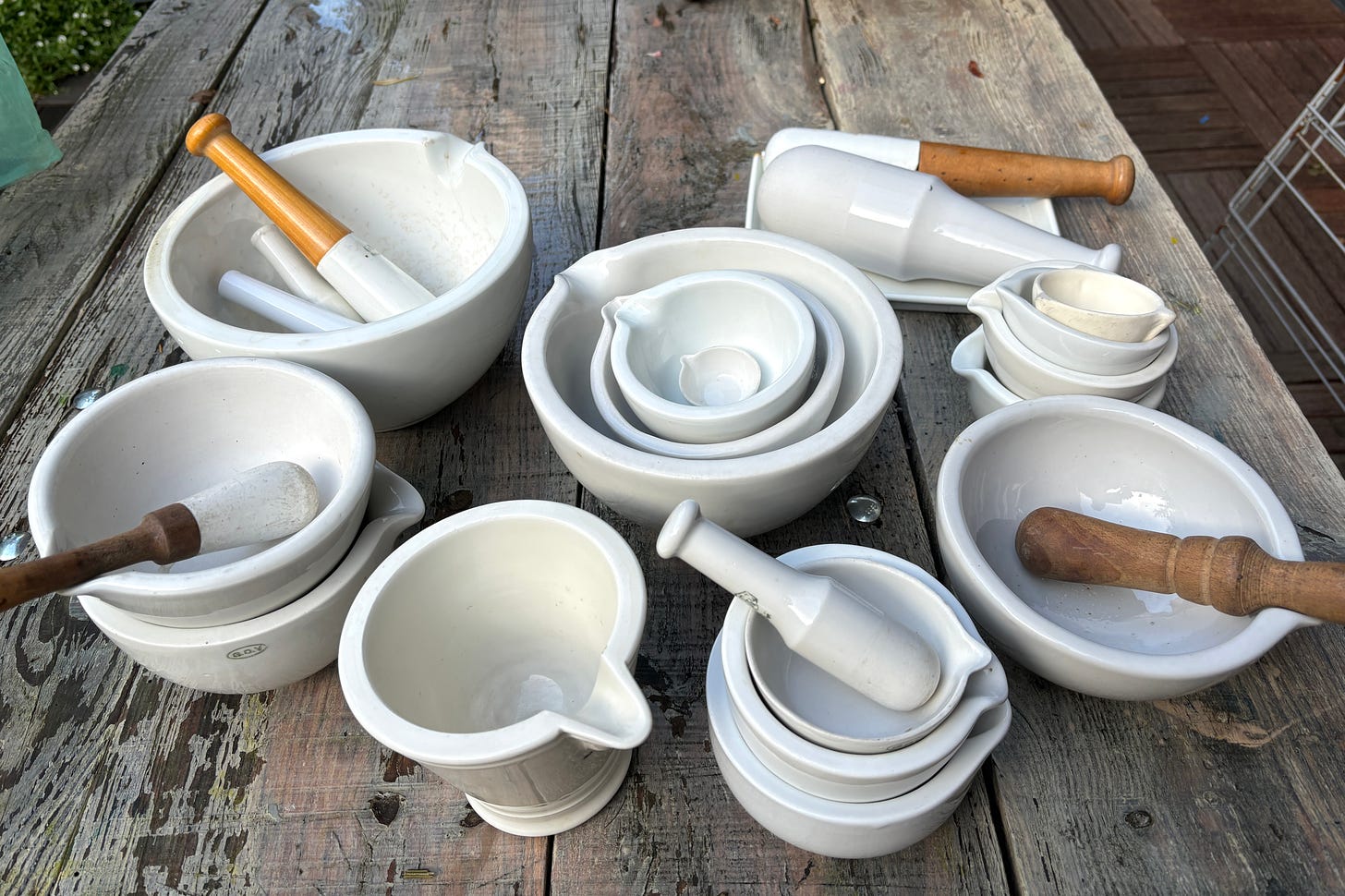
Before hitting the road, you can research through websites and apps like Brocabrac, Vide-Greniers.org, and Brocmania, which lists flea markets by départment (region) and town or village. Their websites and apps all have quite a few pop-up ads, so they can be frustrating to use on your phone while in the car, so best to do your research on them before heading out. If it’s raining, do check the listing for the flea market the night before or that morning as they may get canceled if the weather is bad, and they’ll often update that information there.
We arrived at the one above, and instead of finding tables of items to comb through, we arrived at an empty, soggy field.
Here are a few flea market tips:
What we call a flea market in the U.S., in France, is called either a vide-grenier or a brocante. (In Paris, there is the famous marché aux puces flea market in Saint-Ouen, but it’s actually a collection of indoor antique and vintage vendors.)
A vide-grenier is technically an “empty the attic” sale, so you’ll often find the majority of items are used contemporary housewares, clothes, kids’ toys, and other things people are trying to get rid of, although you’ll likely find some vintage things mixed in; I’ve found Le Creuset pots and gratin dishes, and Mauviel copper cookware, cheaply as younger people aren’t as interested in cooking with them as we are.
A brocante is used to describe an outdoor market where older items are sold, and often there are dealers there selling, as well as regular folks. But it’s also used to describe stores (like the picture at the very top of this post) or brocantes, like the one above, located in a hangar, which bills itself as a “grand brocante.”
Dépot-ventes are technically consignment stores, where people leave items for sale and the store takes a cut, but in my experience (i.e., visiting a lot of them), few actually are consignment stores and most are brocantes. The term braderie is sometimes used as well. In the past, it was used as a place where shopkeepers sell off their stuff at a discount, but like the enormous Braderie de Lille, it could just be a flea market. An antiquaire is a standard antique shop, run by a professional.
A Broc Troc is a store where people bring in old appliances, DVDs, stereos and electronics, used computers, and modern, used furniture to sell. Anything with Troc (which means “barter,” in French) or Cash (such as Troc Cash or Easy Cash) in the name is usually one of those places. They’re not good places to shop if you’re looking for anything vintage.
To find flea markets in France, I often look for them on Google Maps. When we’re driving around I use the “search this area” function. I used to try all the different names for them—’brocante’, then ‘dépot-vente’, then ‘antiquaire’ all of which yielded inconsistent results—until I decided just to type in ‘depot vente brocante,’ which does the trick. Note that some are better (or worse) than others, so look at the photos, which will give you some idea of the quality and types of items that they carry. Also check opening hours; In France, businesses adhere strictly to them, and many shops outside of Paris close for an hour or two at lunchtime.
Emmaüs thrift stores are also favorite places to stop at in France. Most cities have an Emmaüs shop; some are small and mostly carry used clothes and used (contemporary) housewares, but others are large warehouse-like places, generally located outside of town.
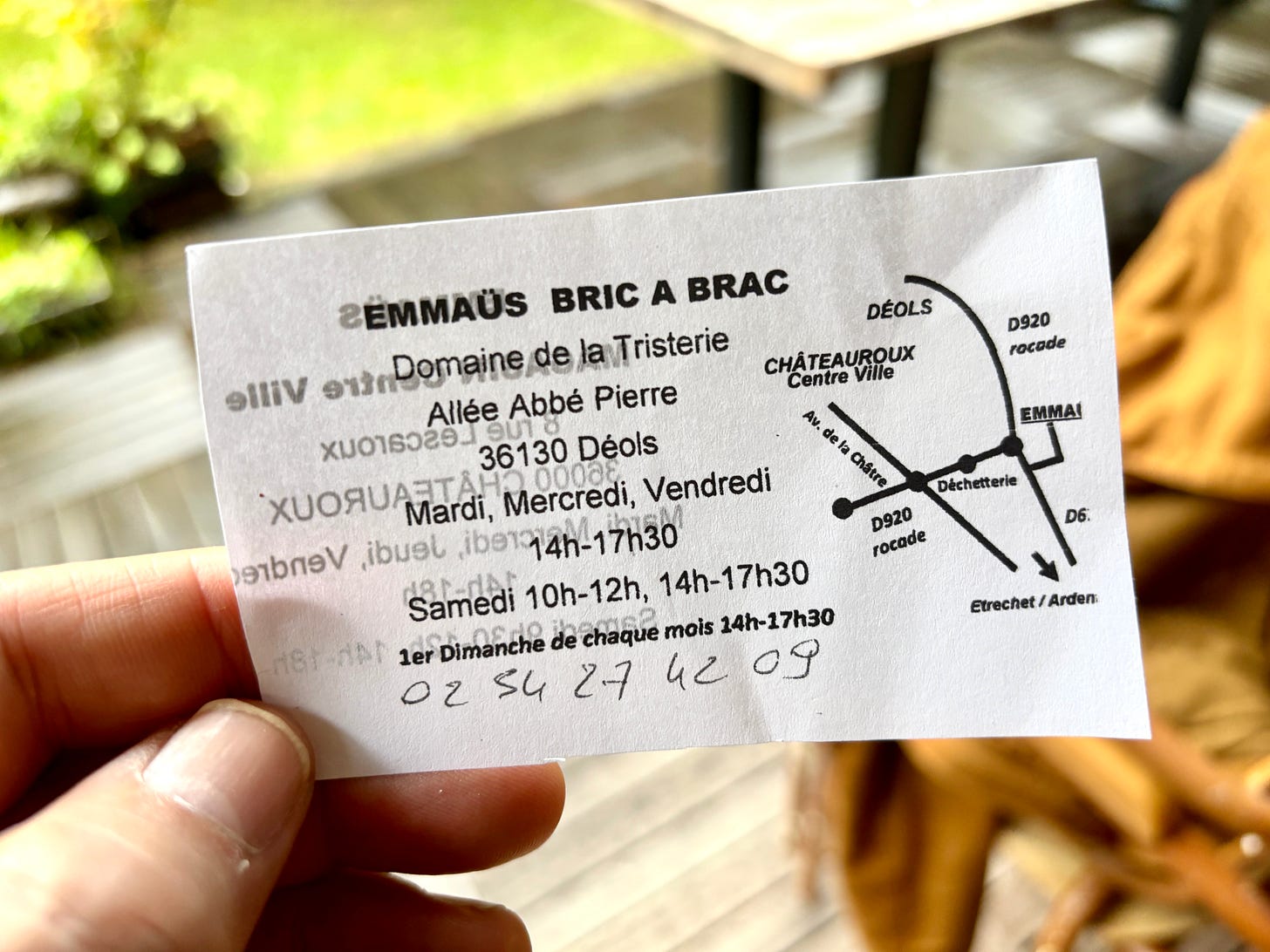
Emmaüs stores have wildly varying hours; some are only open one day a week or one afternoon a week, and others open several. So best to check their website or hours on Google. Their thrift stores differ radically in terms of selection and quality; some have great vintage finds, and because the stores also serve underprivileged communities, others may have only used clothes, toys, and everyday housewares.
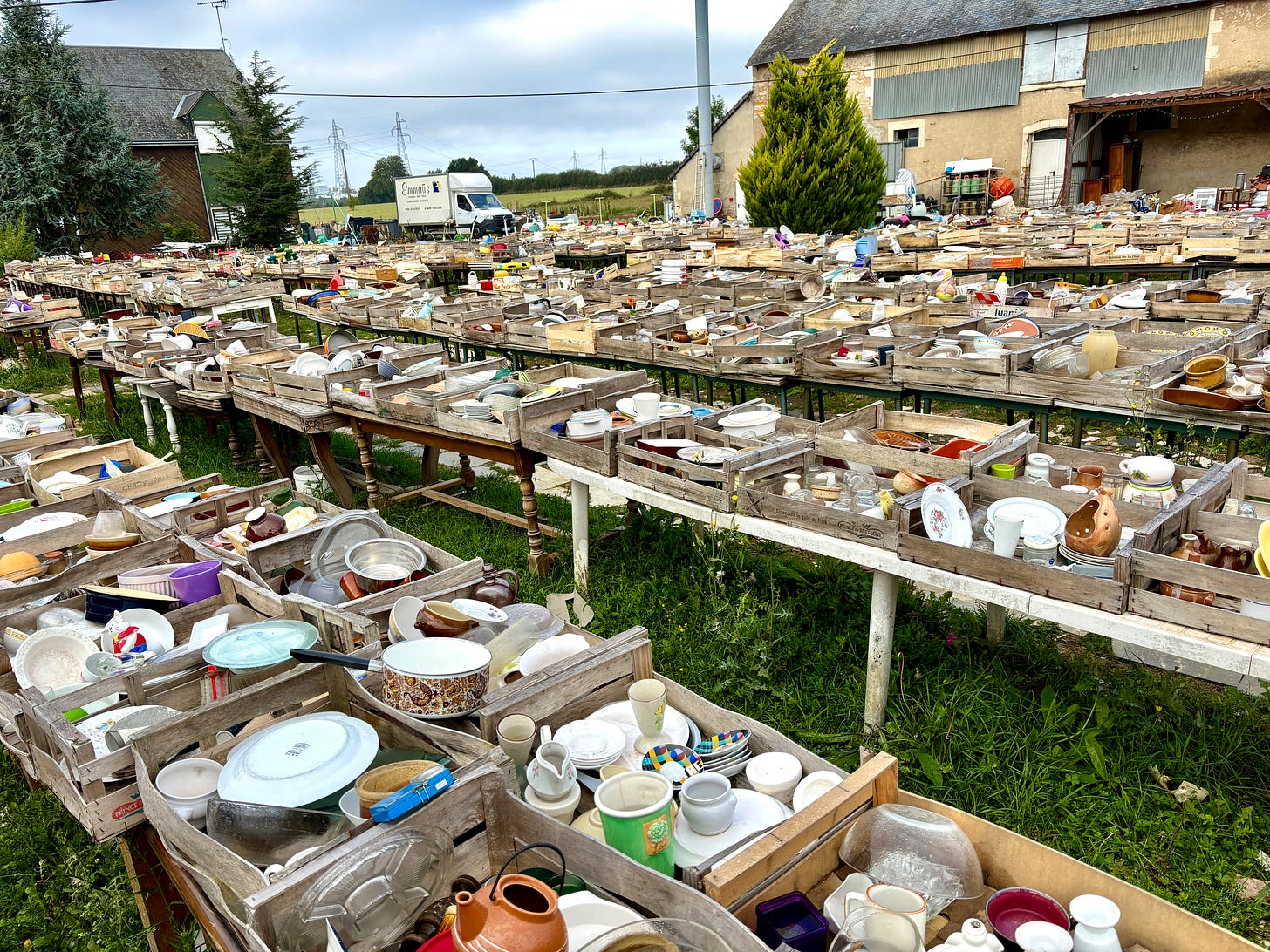
When you shop there, items may or may not have price tags on them. Most stores are divided into sections, and when you find what you want in one section, say, Books or Kitchen items, you bring it to the desk in that section where they tell you the price (if they’re not marked), then they give you a paper ticket to bring to the main cashier to pay for everything. Then you go back with your ticket, marked as paid, to retrieve your items.
I often rely on Google Maps, rather than the website, to find their stores. The ones located in cities, such as downtown, are generally as good as the ones outside of town. Note that Emmaüs also provides lodging, assistance finding work, and help for people in need, so not all of their addresses have thrift stores. I usually look at the photos on Google Maps to determine if an address is a thrift store.
Get to flea markets (brocantes and vide-greniers) early in the morning for the best selection. You’ll find better things early in the day (starting around 8am) when people are setting up, but getting there early means you’ll have to walk around while people unpack. While prices may get lower around closing time, the best finds are in the morning.
That said, people in the countryside aren’t necessarily on the lookout for vintage cassoles (cassoulet dishes) or tians (the cassole’s Provençal cousin), bistroware, and wooden cutting boards, but antique dealers may be. However, I bought that large cassoulet dish, above, around 11am, which no one seemed to be interested in. That one, I’m not sure where I’m going to put it; however, I was not going to leave it behind.
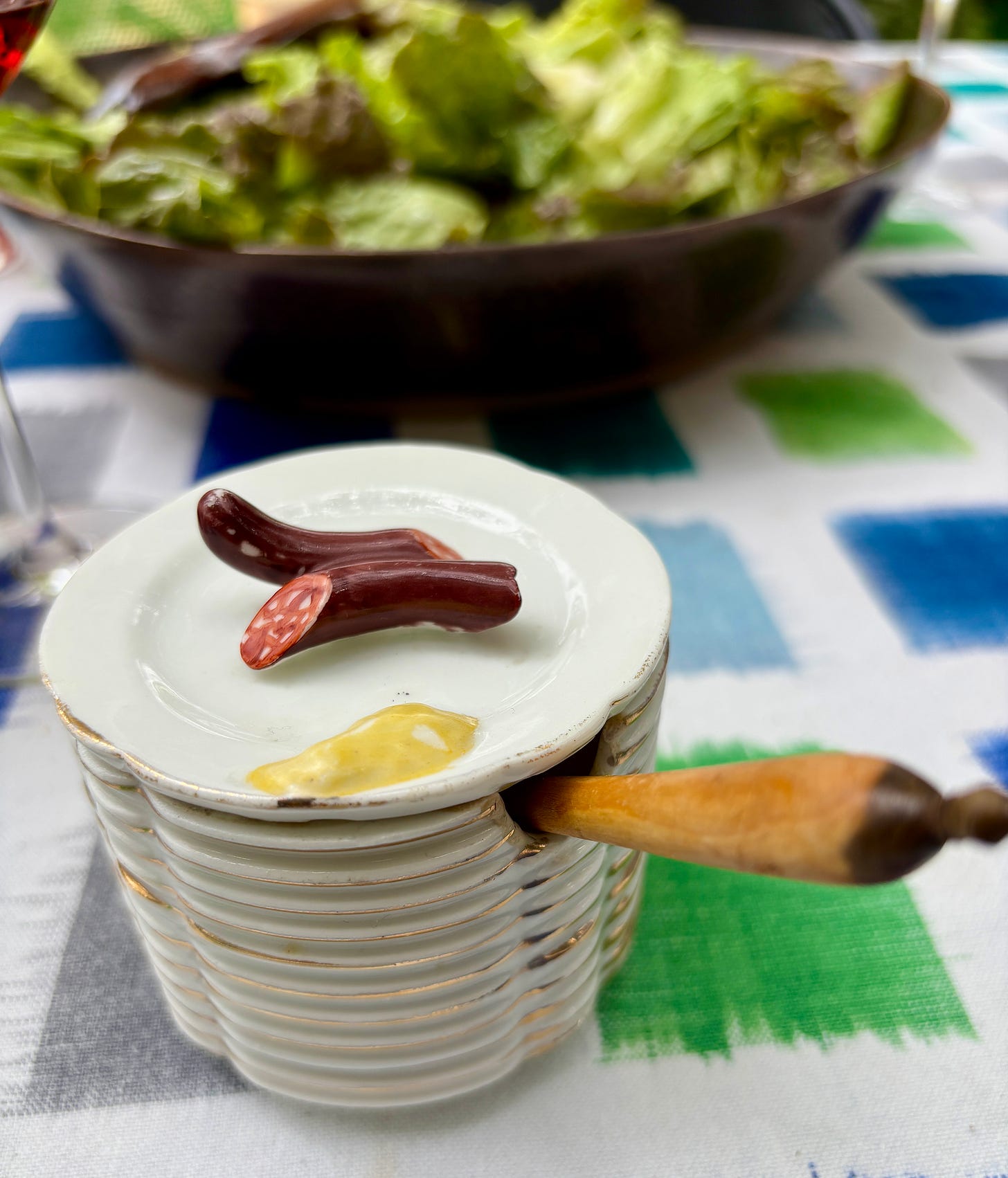
I also got a vintage flame-colored (called Volcanique) Le Creuset enamel gratin dish at a very crowded flea market that was in perfect condition, just sitting there, untouched in the early afternoon. They retail new for $150-210, and when I asked the price, she told me it was two euros ($2.50). So I bought it.
A few more tips:
Bring small bills and coins. Spend a few days before you hit a flea market by breaking any bills larger than €10. Few people will have change early in the day, and you also don’t want to haggle someone down a euro, pleading that something is too expensive, then whip out a €50 bill. I like to bring a lot of change, too, since things I like are often €1.
Bring a big shopping bag. Supermarkets in France sell large reusable shopping bags, and Ikea stores do as well. They’re lightweight and great for hauling things. I make sure to bring one with a shoulder strap.
Pro tip: My favorites are the ones from Leroy-Merlin hardware stores (they have a few stores in Paris), which are wide, so things lay flat in them, and cost around €2. Bonus: Because they have a lie-flat bottom, they’re also excellent for transporting cakes and tarts.
Don’t be afraid to bargain. When we travel, many of us tend to be more timid than we are at home. But it’s almost expected that you bargain. Not everyone wants to lower their price, and, yes, like everywhere, some people are unfriendly in France. You don’t want to insult anyone by offering €10 for something that’s marked €100, but offering 10-30% less isn’t unheard of, and yes, sometimes people offer 40-50% less and get it.
If something is €20 and I want to buy it for €15, I might start at €12. If you’re timid, as I can be, start at €15 and prepare to be firm, although you’ll likely end up paying €18. The French have an expression: To cut the pear in two, which means you split the difference with a vendor. If you throw out that expression, “Couper le poire en deux,” they may chuckle that you even know that expression, especially if you have a foreign accent, and go for it.
When negotiating, hold the item in your hand as it’s “flea market manners” not to butt in when someone is negotiating for something with a vendor. But once you put it down and take your hand away, you might lose it. That happened to me with a nice mortar and pestle at the Aligré flea market in Paris. Once I put it down, a dealer quickly grabbed it.
My advice is always: Decide how much you want something while you’re bargaining, and if you end up paying a little more, don’t worry about it. You got something you wanted. Sometimes you’ll pay too much, and for other things, you’ll get a bargain. In the end, it all works out.
Check the condition as everything you buy is buyer-beware, sold as is. Any scratches or discolorations are normal, but chips and especially cracks will/should greatly reduce the price. Always tap the sides of any bowl, vase, or plate you’re buying and check to hear if it’s solid. If it feels a little crackly when you tap it, it’s a sign there may be a hairline crack in it. Some are barely noticeable to the eye so take a good look.
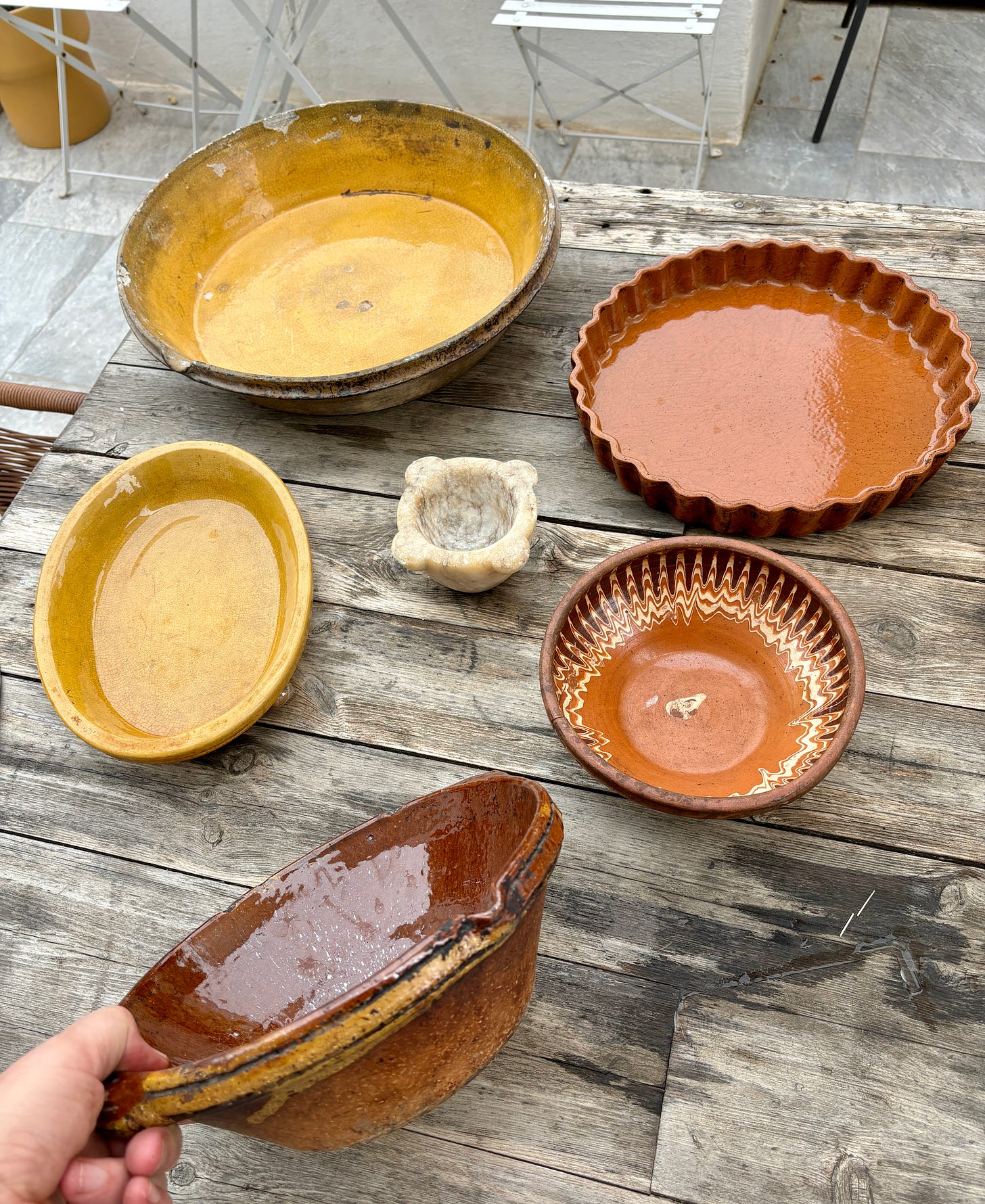
Many brocantes, depot-ventes, and antique stores aren’t open daily, so be sure to check the opening days and hours. Almost all are closed on Sunday, and some close midweek when they’re less busy. Google does a pretty good job confirming with merchants when they’ll be open (one merchant told me they get an automatic message every two weeks to confirm their hours), but the hours are not always 100% right.
Before driving a long distance, call first. A number in France that begins with 06 is a mobile phone number. A lot of antique stores and brocantes don’t have websites, but many have Instagram and Facebook pages, and you can sometimes send a message there and get a response, or they’re more likely to keep the opening and closing hours updated there, rather than on a website.
One of our last stops was an antique shop out in the middle of nowhere. While we were poking around, I noticed, gulp…an old mortar (below), which caught my eye, and I thought might look nice in our garden. But then I noticed the table under it…
It’s made of heavy aluminum with sturdy metal legs, and I liked the industrial materials and the form. The owner said it was from an old orange processing facility, which made it extra appealing to me. He also had some interesting old French cookbooks and cooking tools and was surprised I knew what all of them were.
No one knew what that was, above…except me. I said it was a spoon rest. So he gave it to me, a gift to go along with the table. (If it’s for something different, let me know in the comments. UPDATE: A few people mentioned it was a scoop for dry goods, but a reader tracked it down using Google Lens and found out that it’s a tool used in mining, for blowing on, to separate dirt and sand from gold. Thanks Linda!)
We ended up buying the table, which fit on top of the car. I wanted the chairs with yellow wooden slats as well, but we didn’t have anywhere to put them.
And for those still wondering what we do with everything, we are using our table almost daily. Well, we were using it, past tense, since it’s chilly and rainy now in Paris and too cold to eat outside. Flea market season is over as well. But come spring, we’re looking forward to using our table every day…and seeing what we find when we’re out and about next year.
*You can find gîtes and chambres d’hôtes on websites such as Gites de France (the official website), and there are Airbnbs and VRBOs, as well as LeBonCoin, under “Locations de vacances” (holiday rentals), which is where some of the best deals are since the proprietors don’t have to pay any fees.
Of course, do your research to avoid scams and negative experiences, although I’ve only heard about them happening through the most well-known short-term rental platform. If you use them, if someone wants to take the conversation to What’s App, that’s often a sign that there may be trouble in the future. You don’t want to go off-platform.




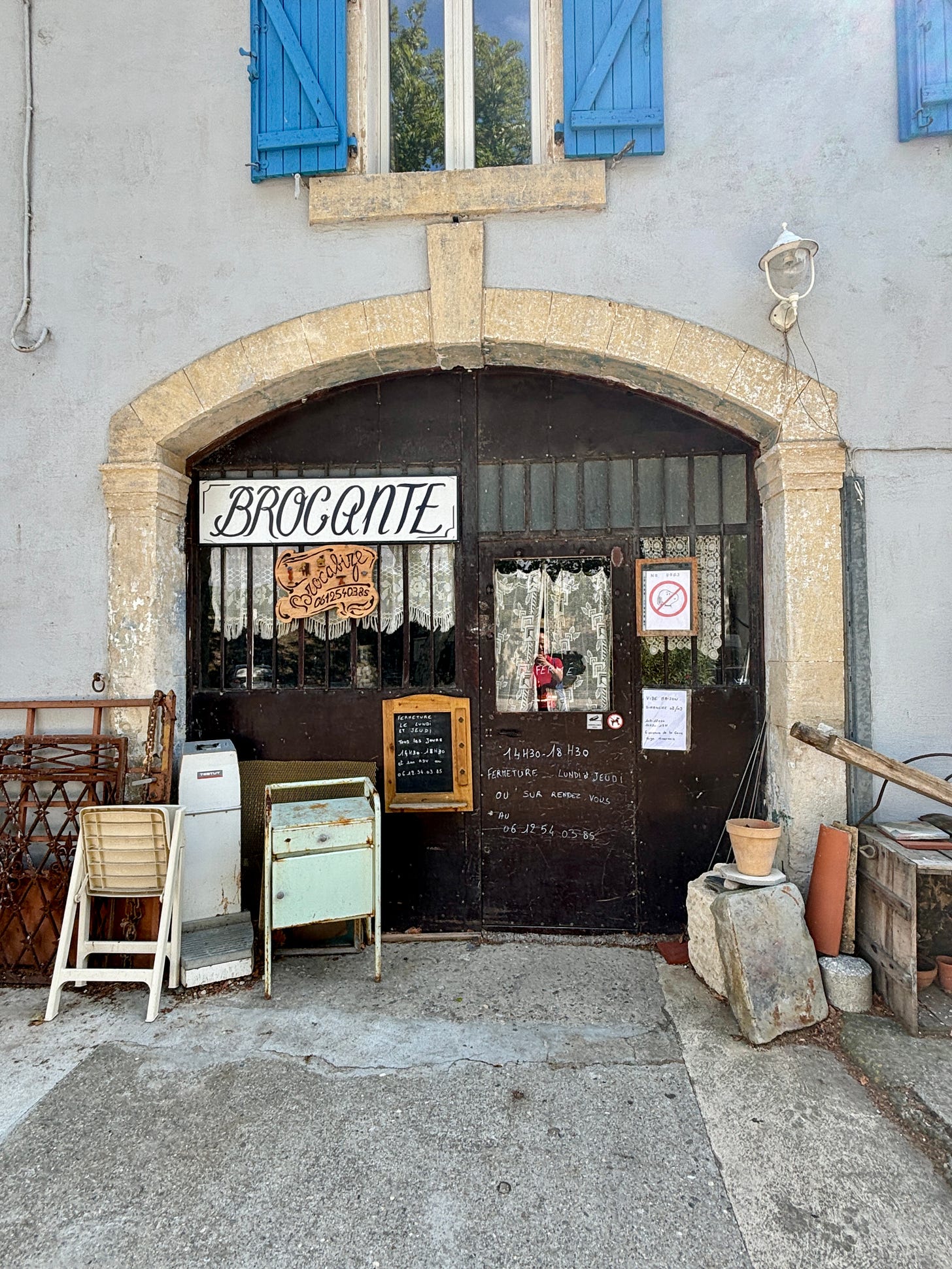
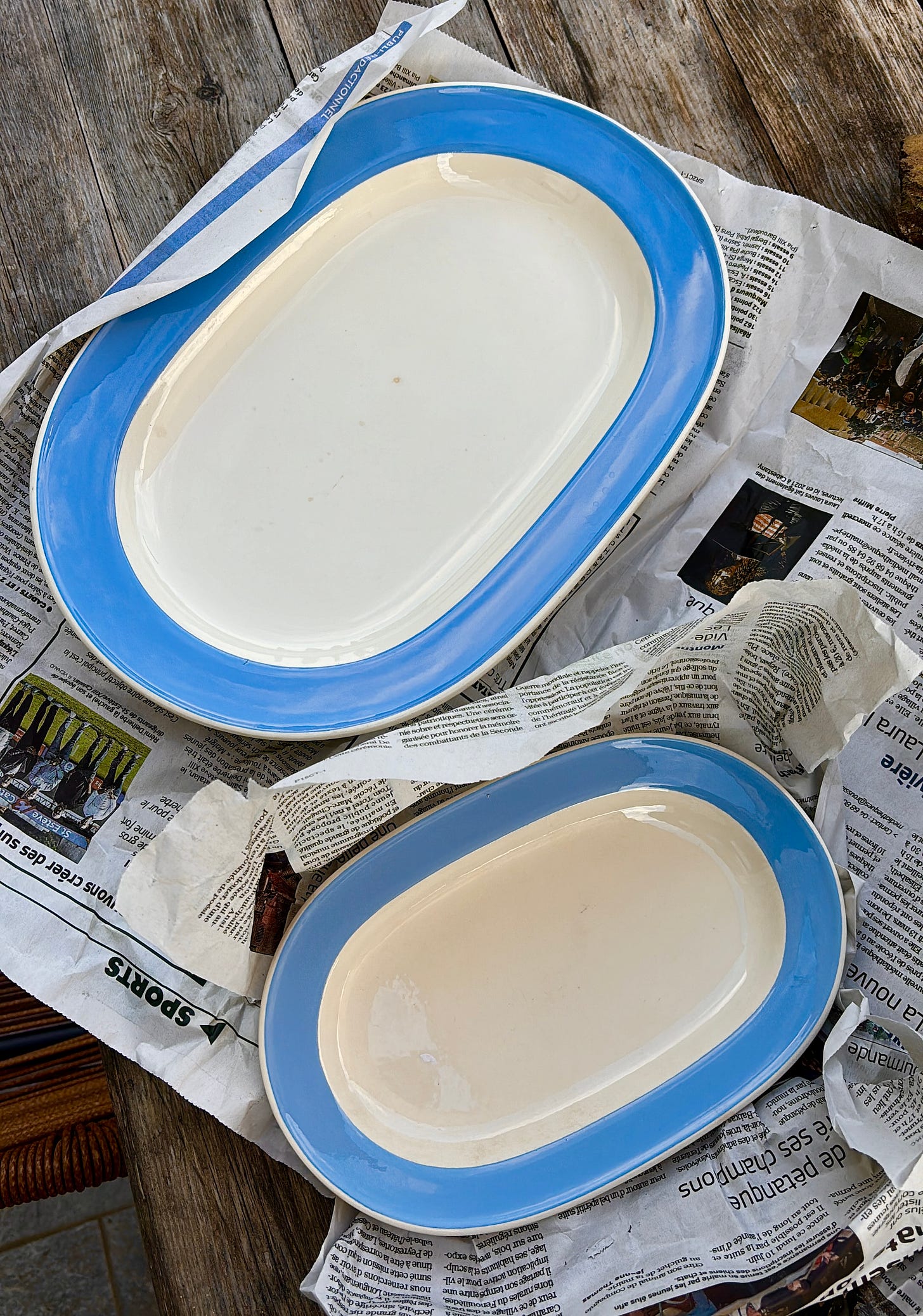
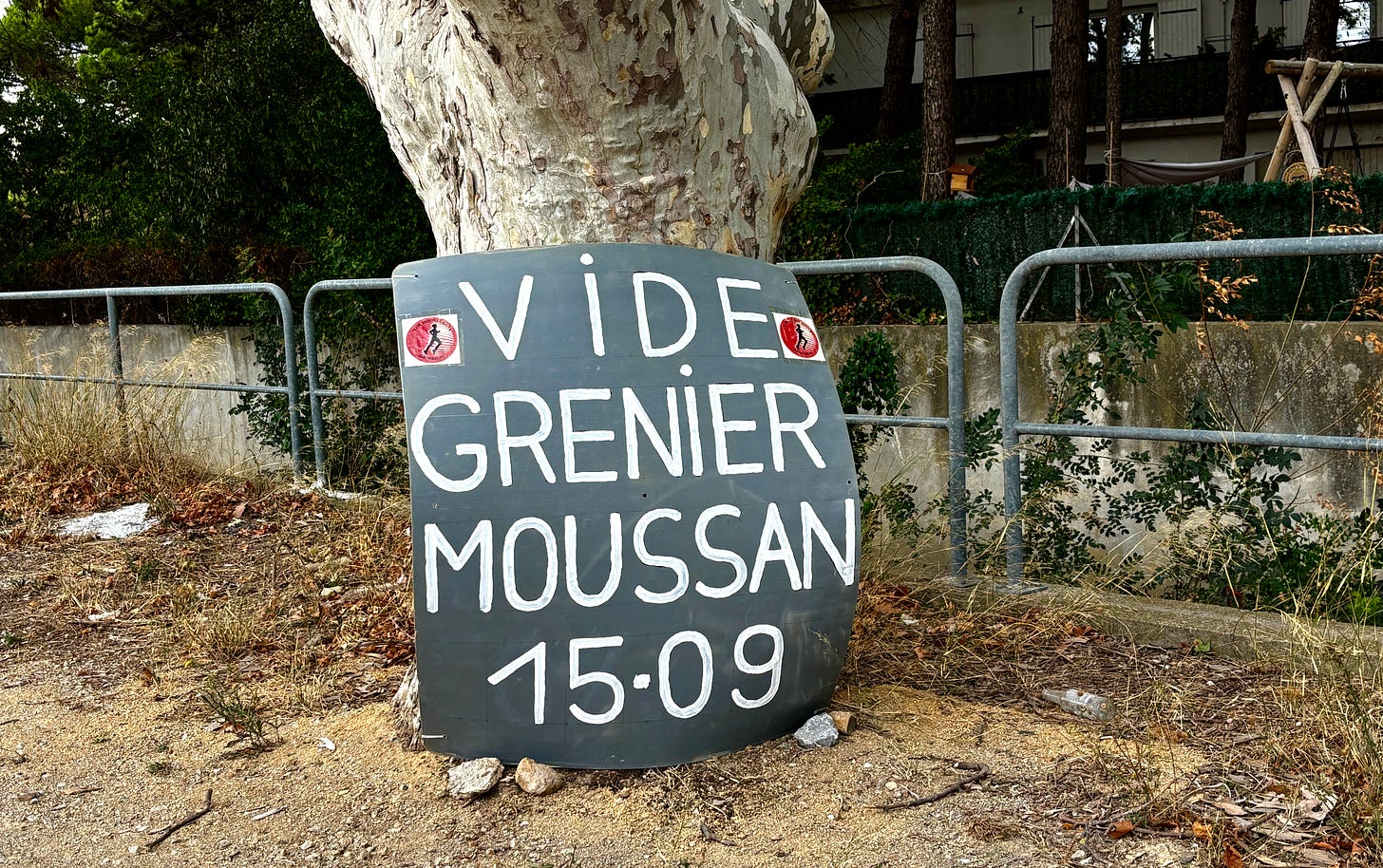
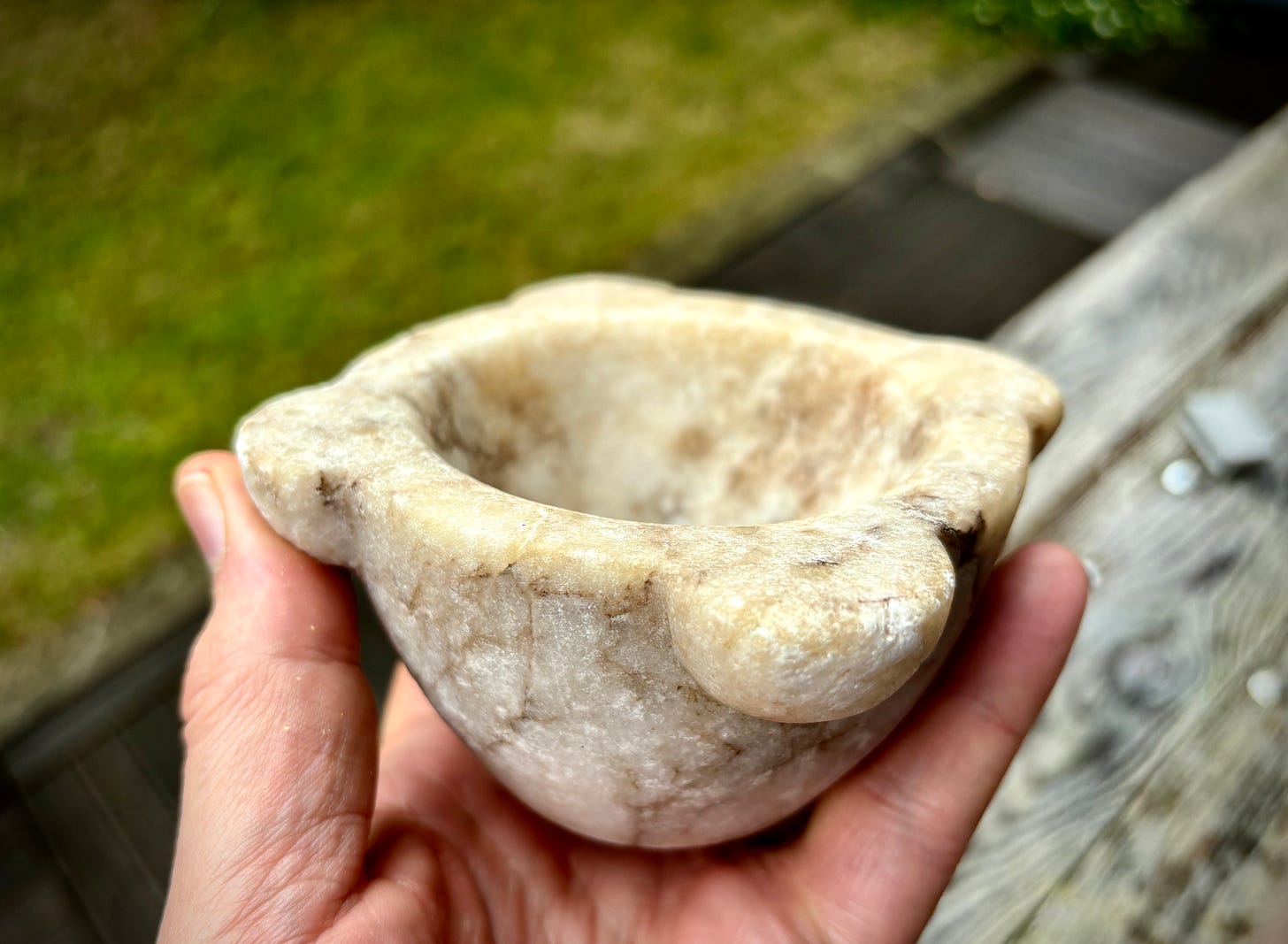
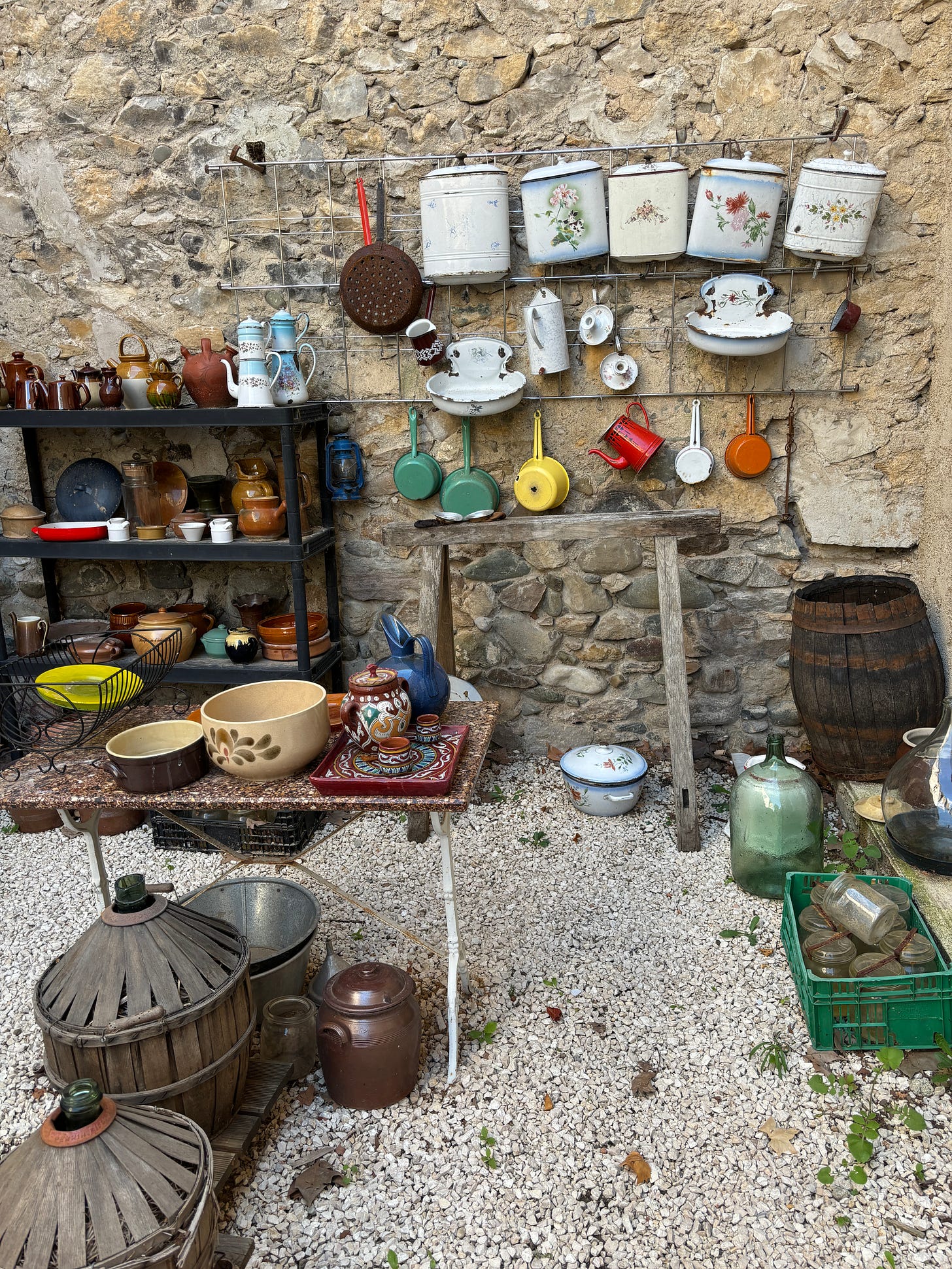
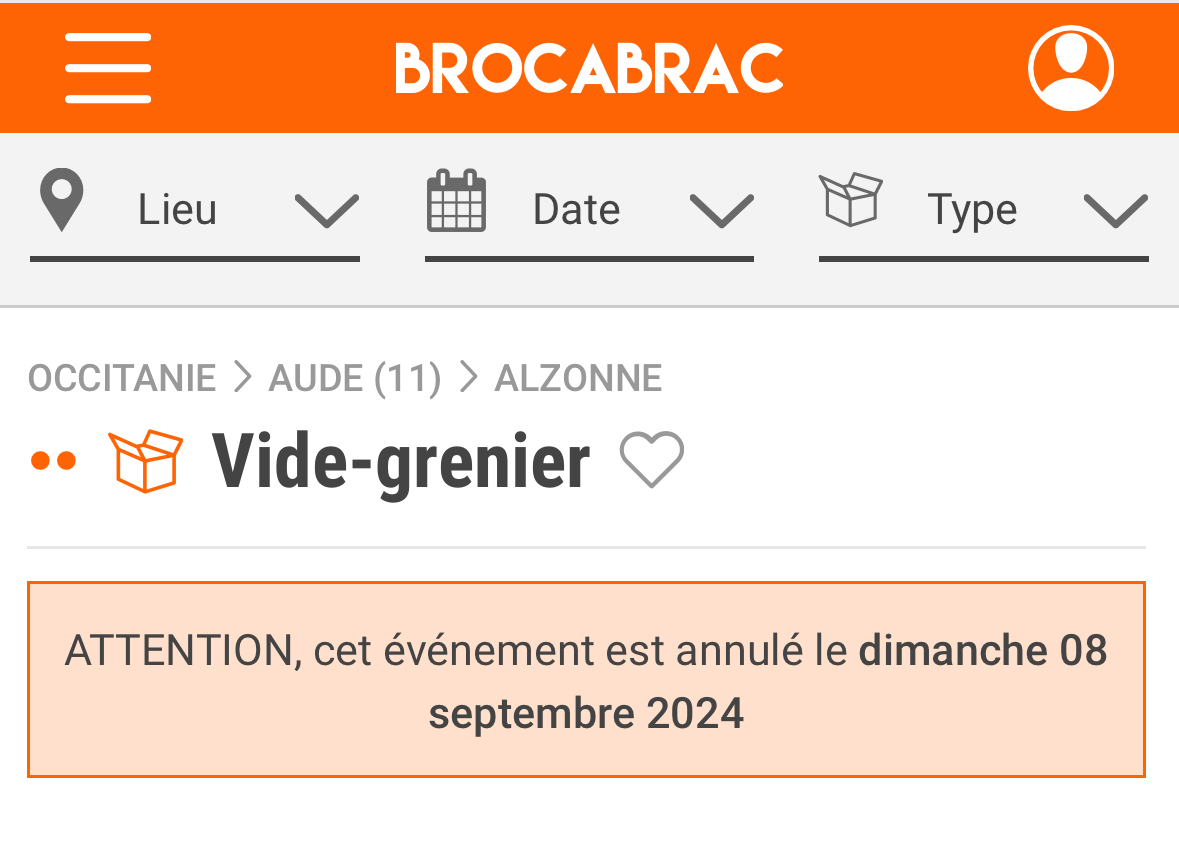

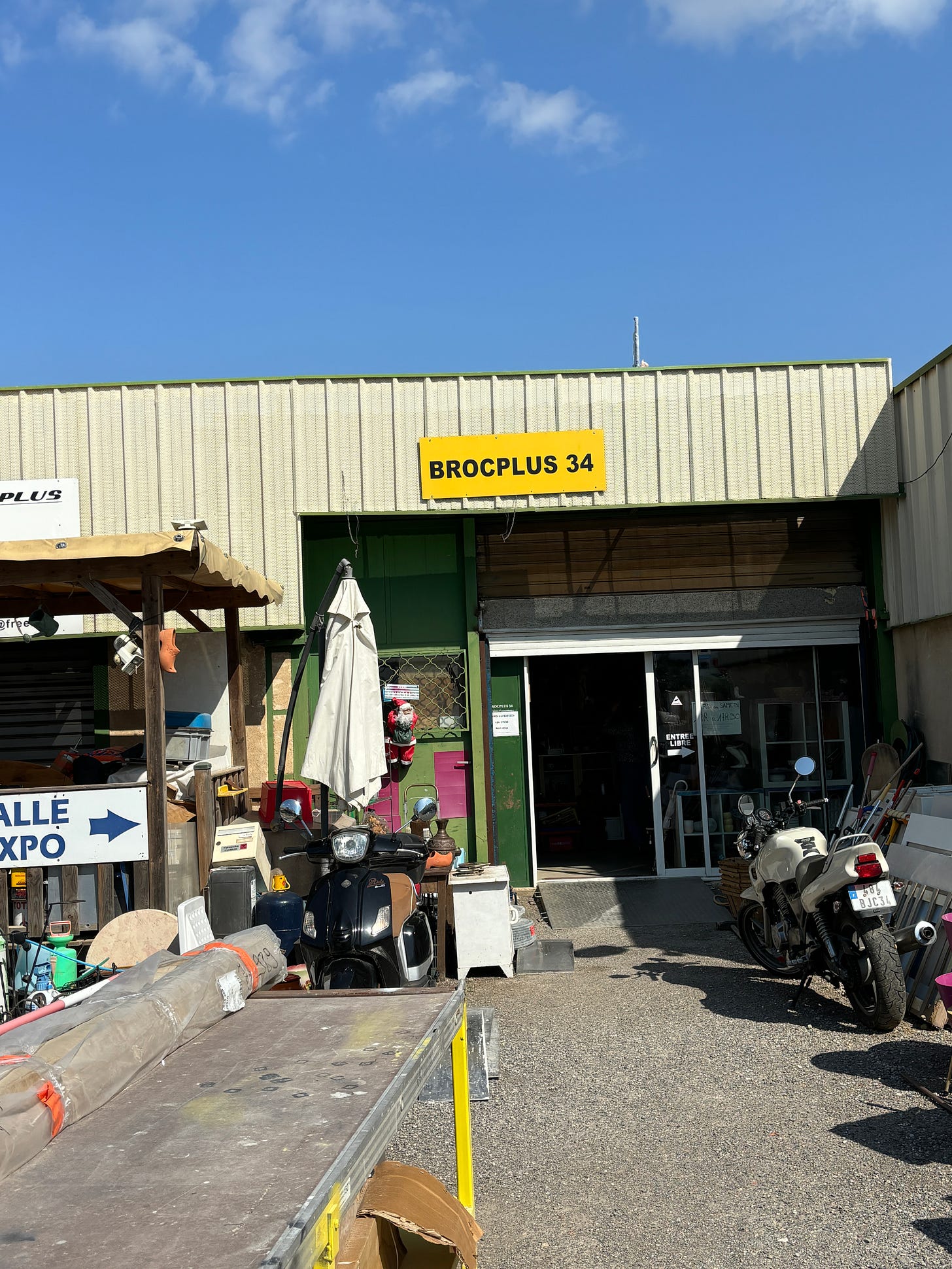


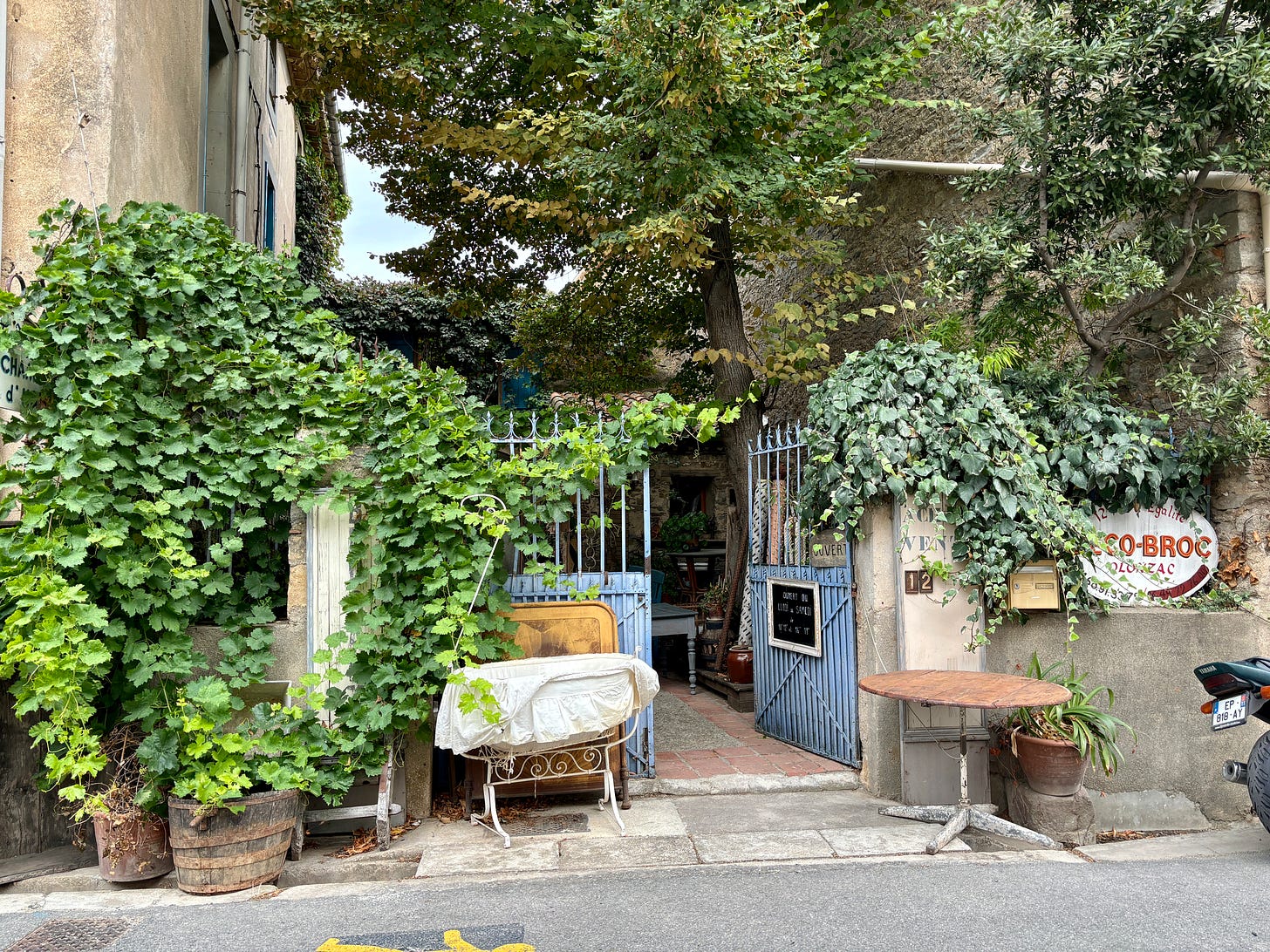

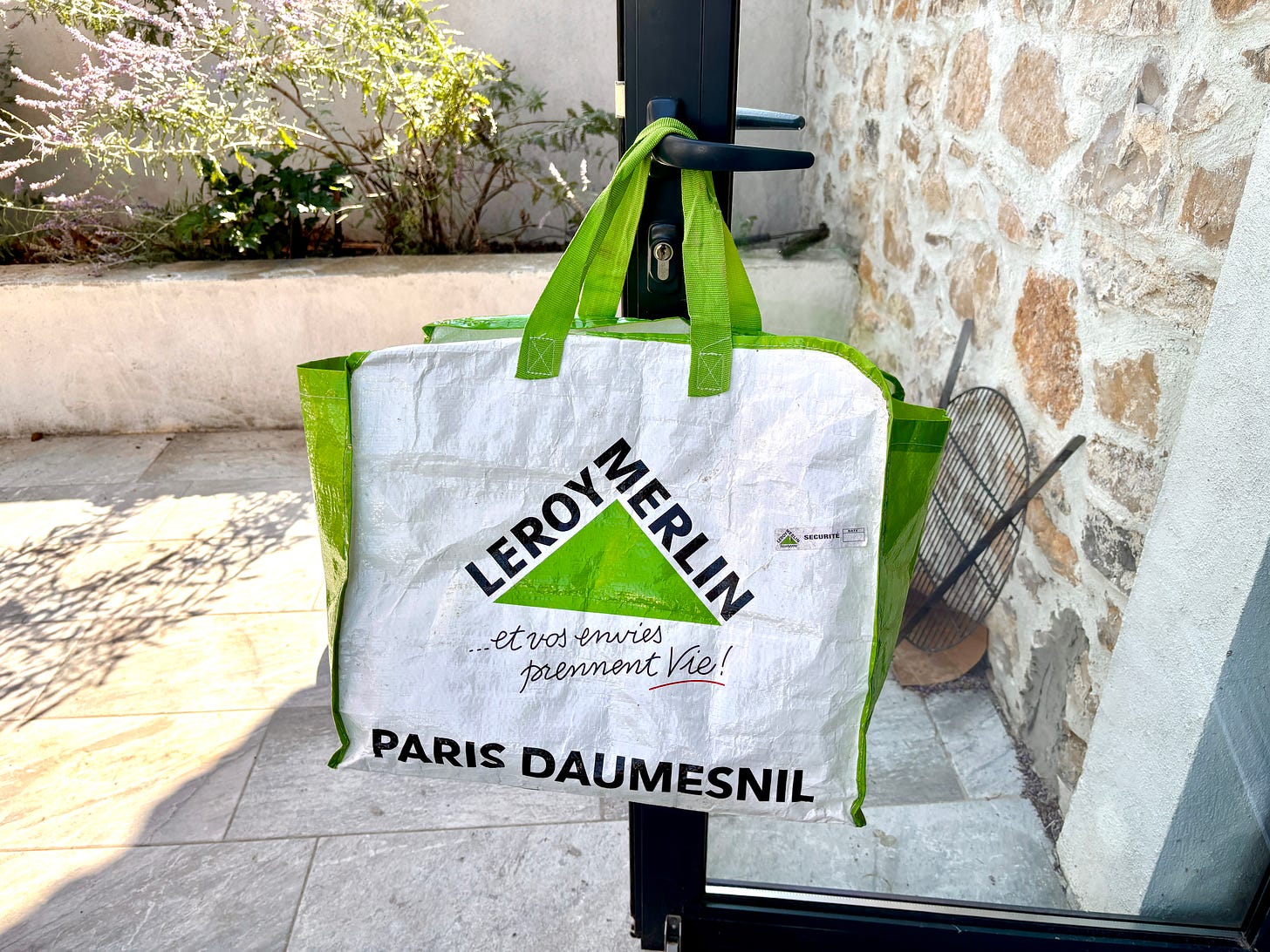
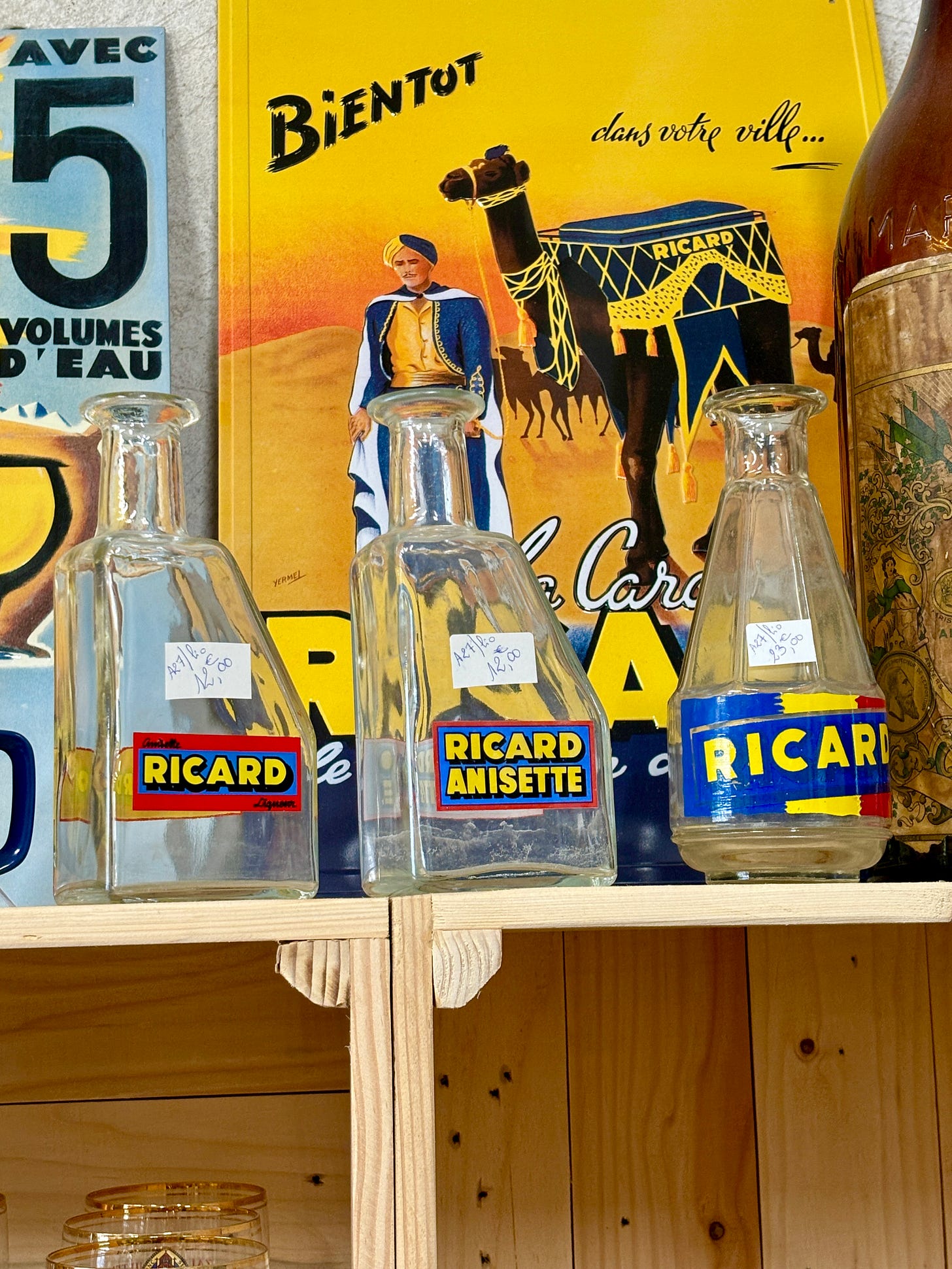
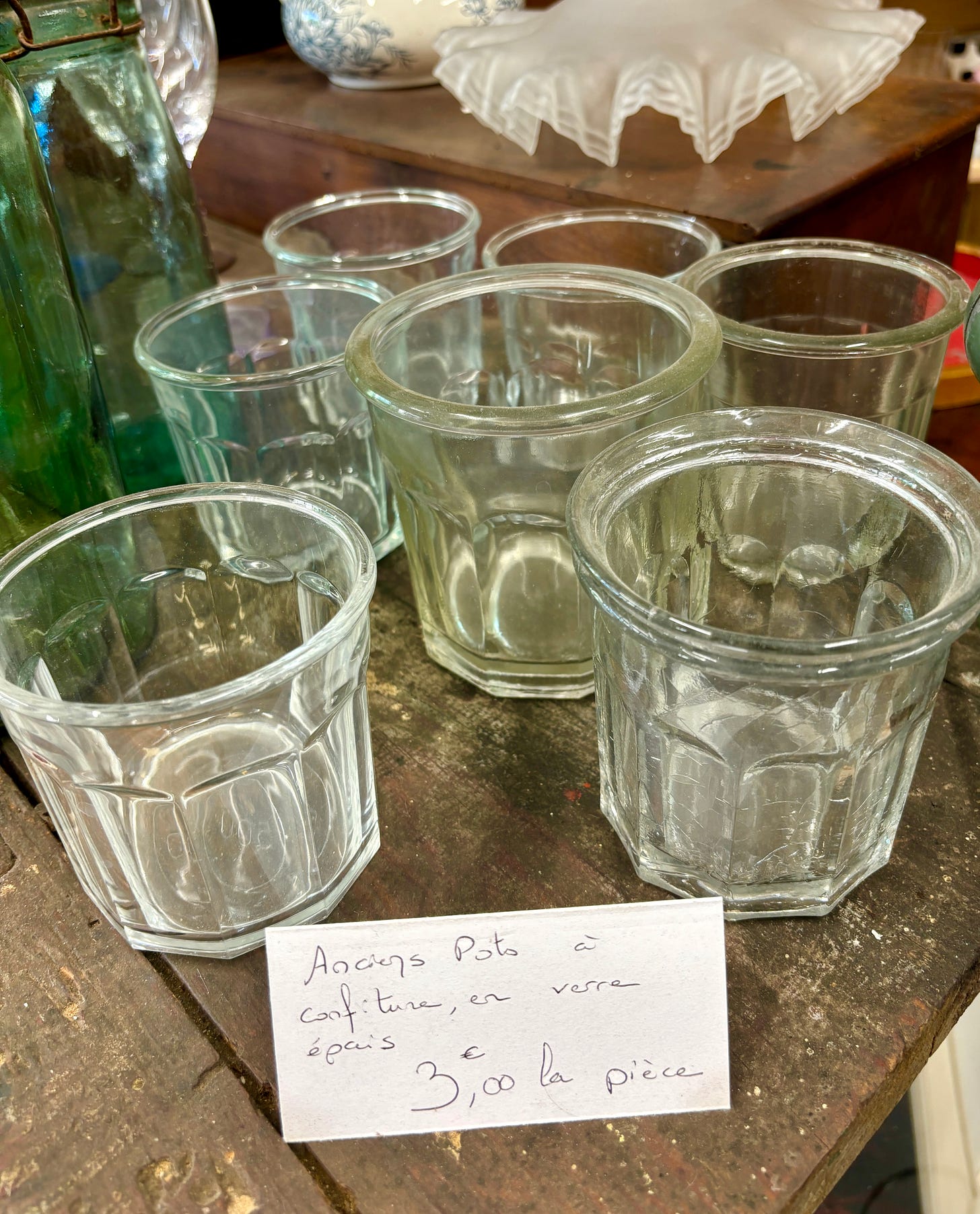
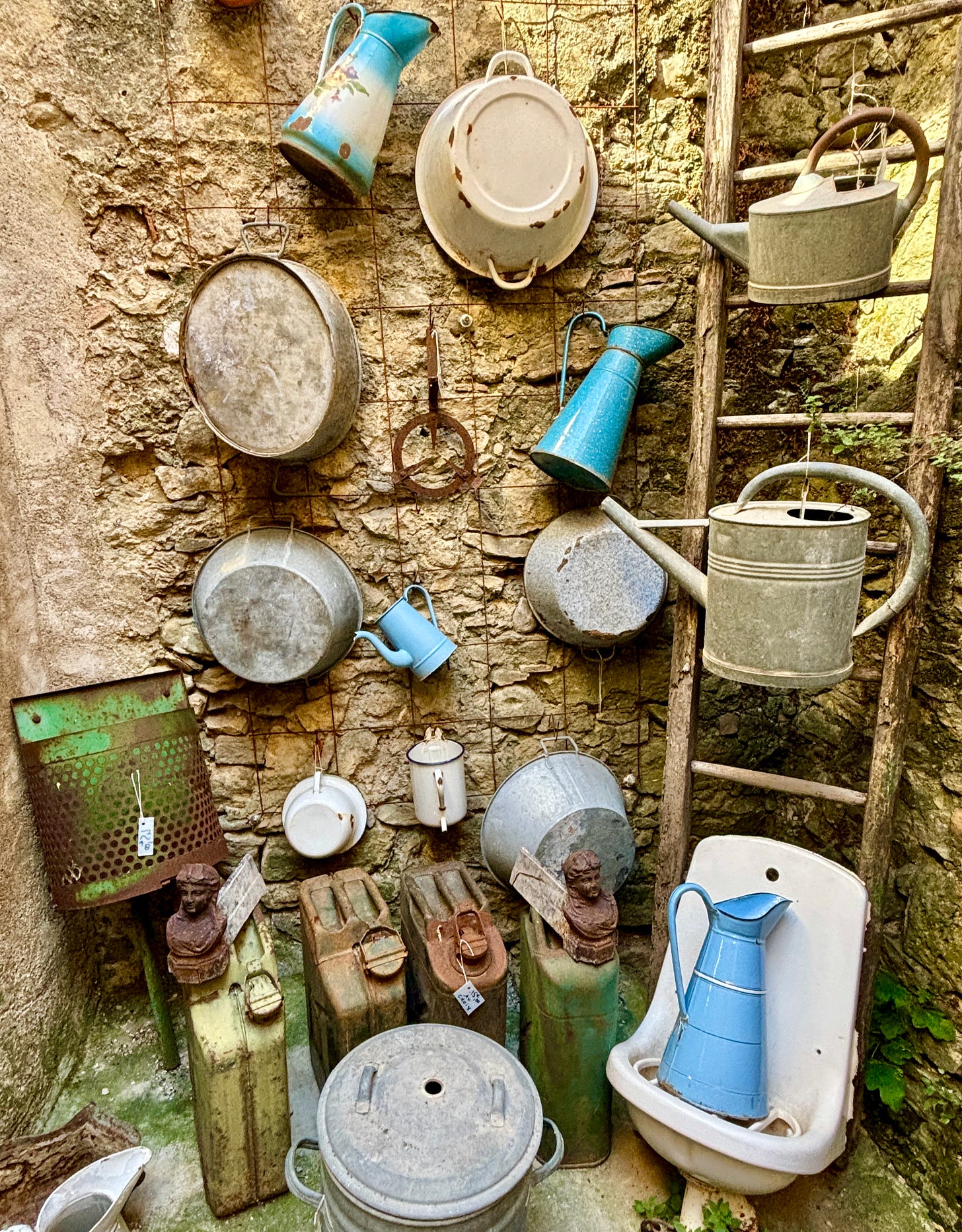
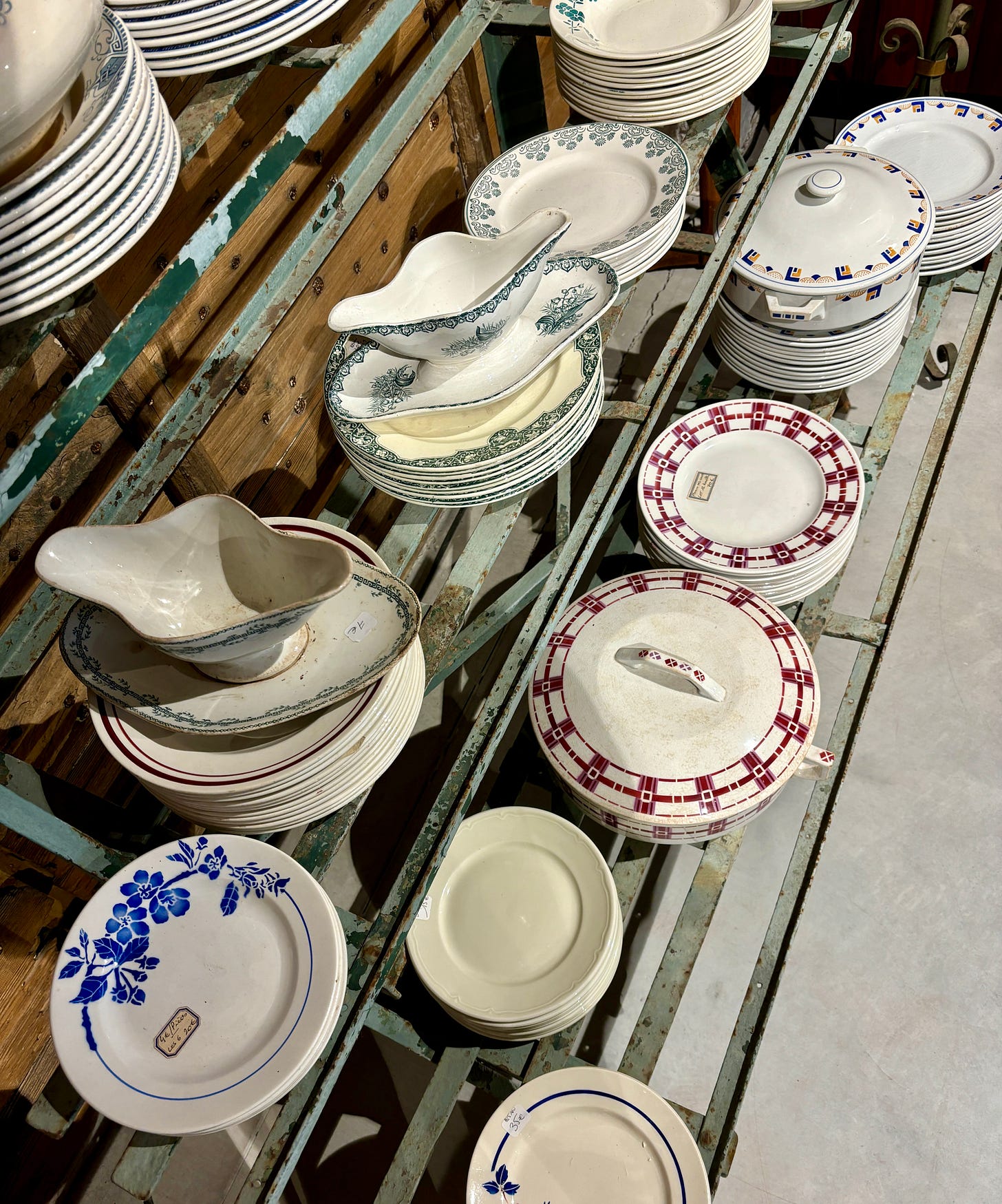
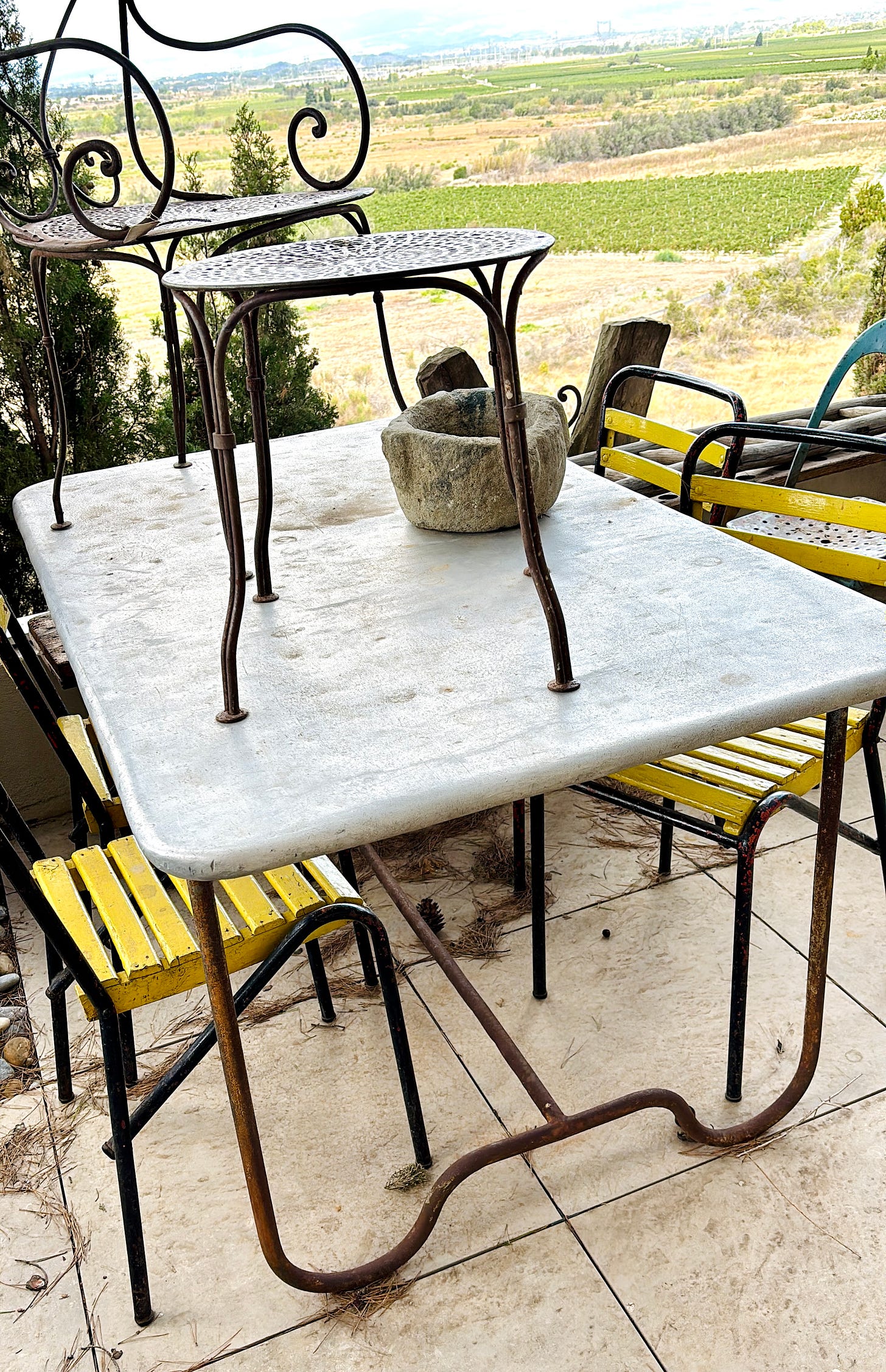

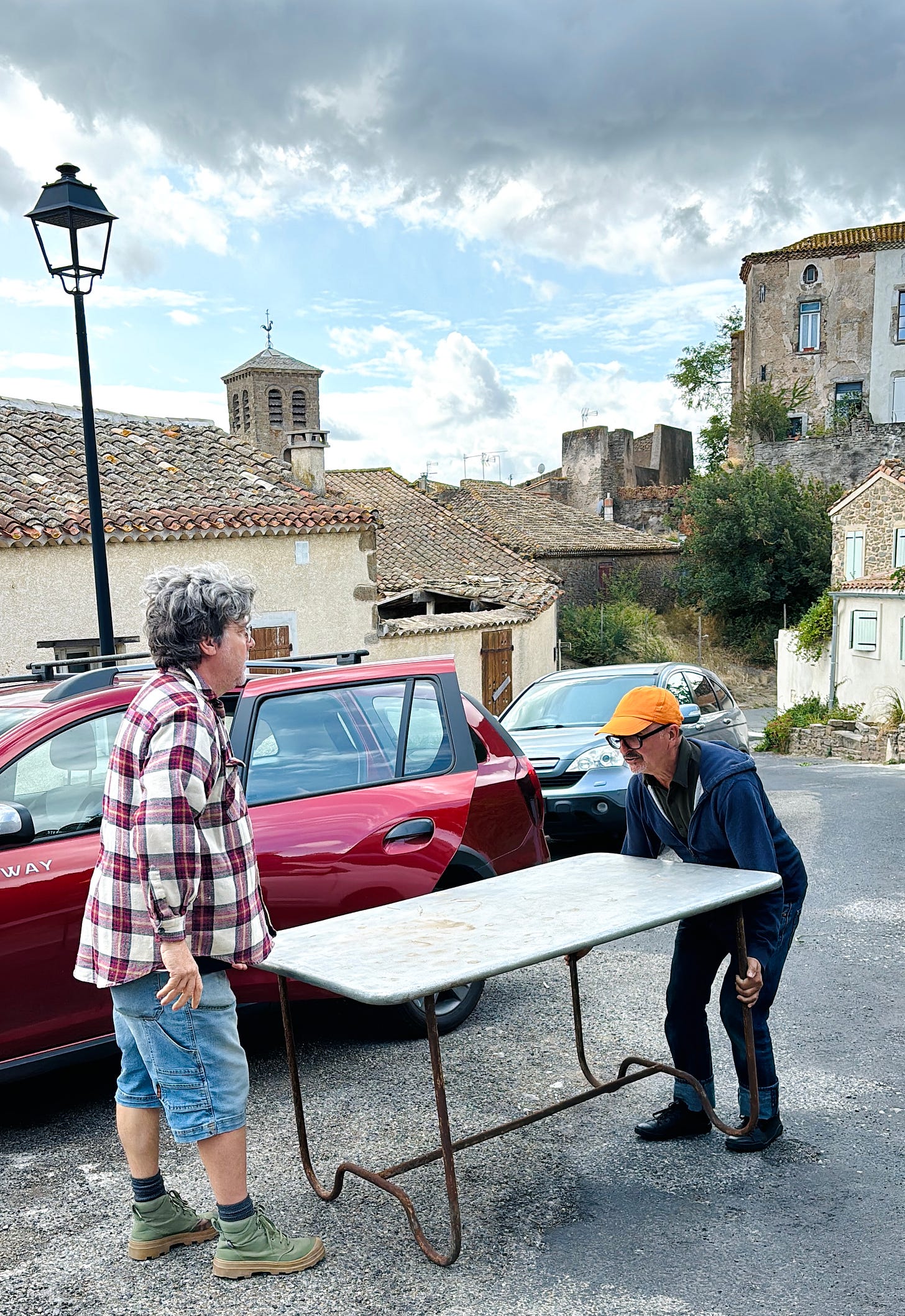
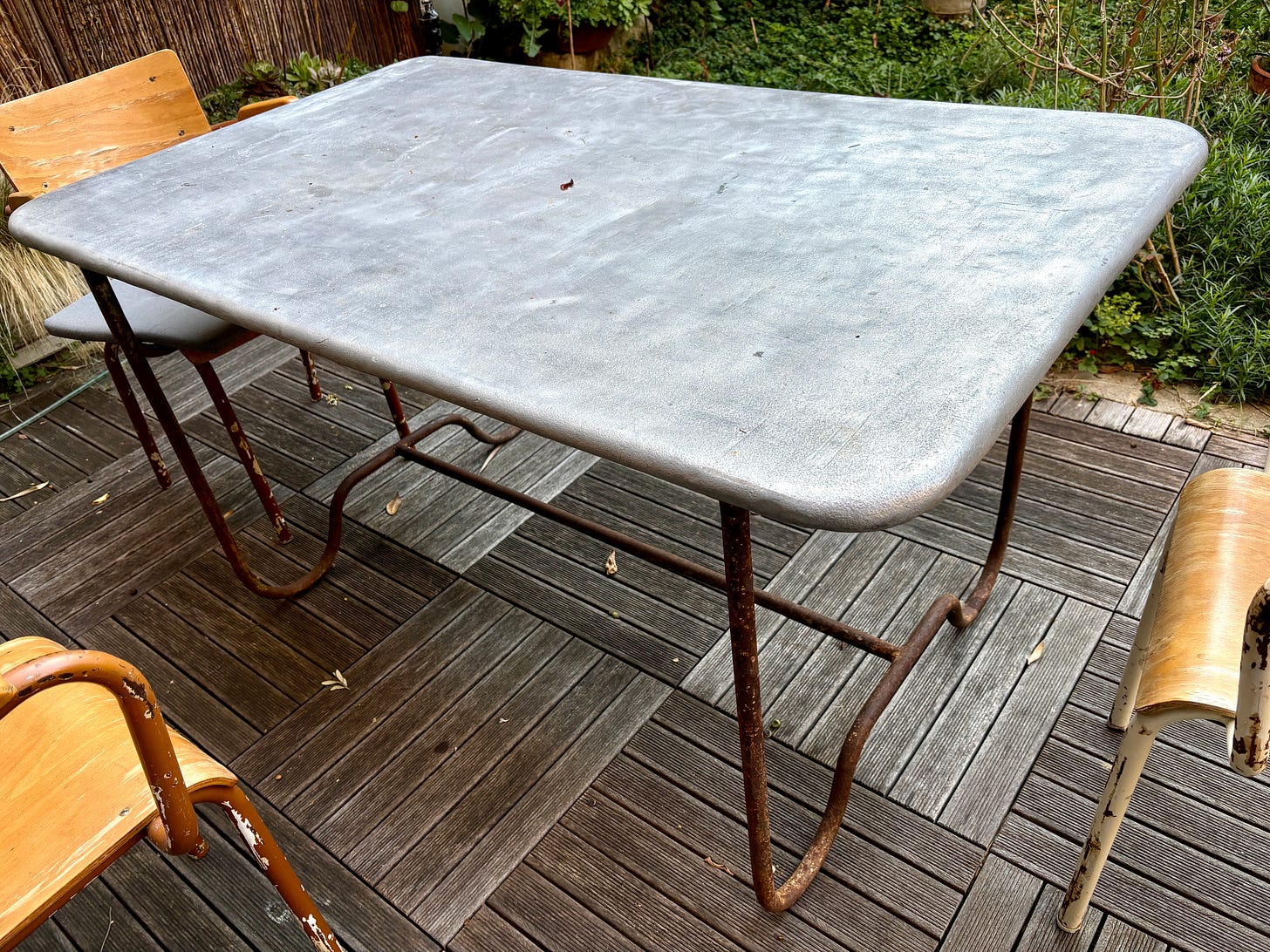

Perfect timing … Xavier and I are rattling around the French countryside . He says your ‘spoon rest’ is actually a scoop for pasta or beans, etc… which were in glass front drawers .. mostly in the small village epiceries… a childhood memory.
What a wealth of information! Thanks for the useful chatty post, David. I feel like I just sat down in your garden with you over coffee and dessert — such a treat!